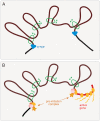The role of transcription in shaping the spatial organization of the genome
- PMID: 30886333
- PMCID: PMC7116054
- DOI: 10.1038/s41580-019-0114-6
The role of transcription in shaping the spatial organization of the genome
Abstract
The spatial organization of the genome into compartments and topologically associated domains can have an important role in the regulation of gene expression. But could gene expression conversely regulate genome organization? Here, we review recent studies that assessed the requirement of transcription and/or the transcription machinery for the establishment or maintenance of genome topology. The results reveal different requirements at different genomic scales. Transcription is generally not required for higher-level genome compartmentalization, has only moderate effects on domain organization and is not sufficient to create new domain boundaries. However, on a finer scale, transcripts or transcription does seem to have a role in the formation of subcompartments and subdomains and in stabilizing enhancer-promoter interactions. Recent evidence suggests a dynamic, reciprocal interplay between fine-scale genome organization and transcription, in which each is able to modulate or reinforce the activity of the other.
Figures





References
Publication types
MeSH terms
Substances
Grants and funding
LinkOut - more resources
Full Text Sources

